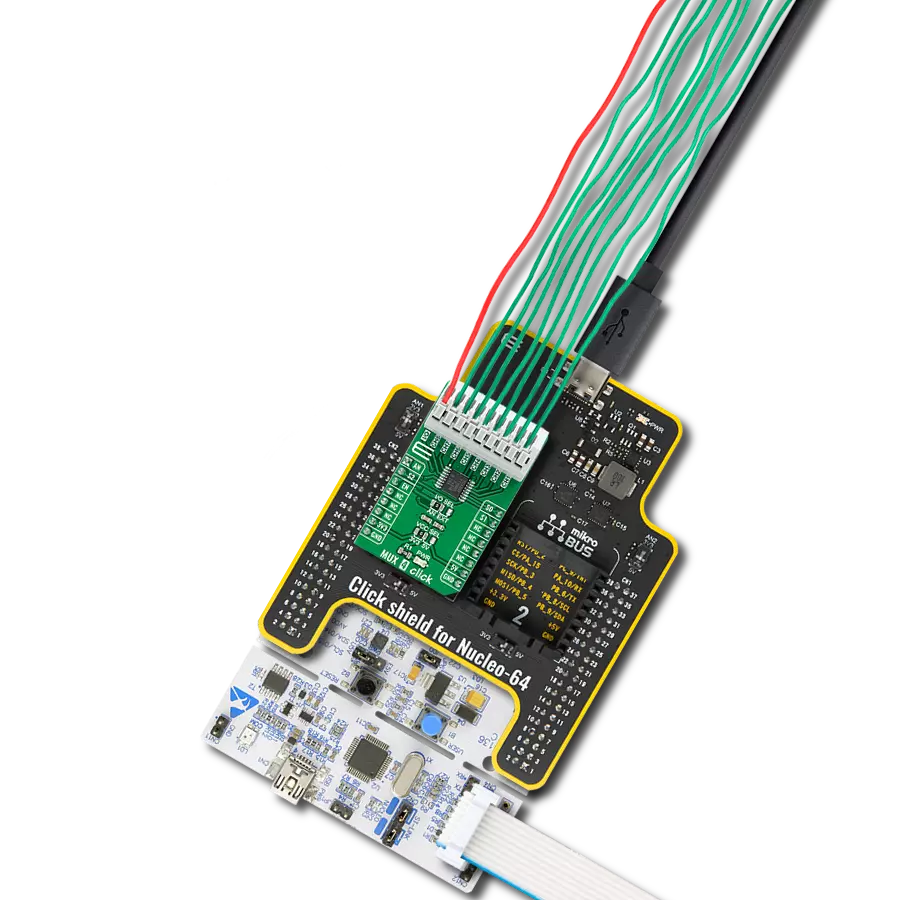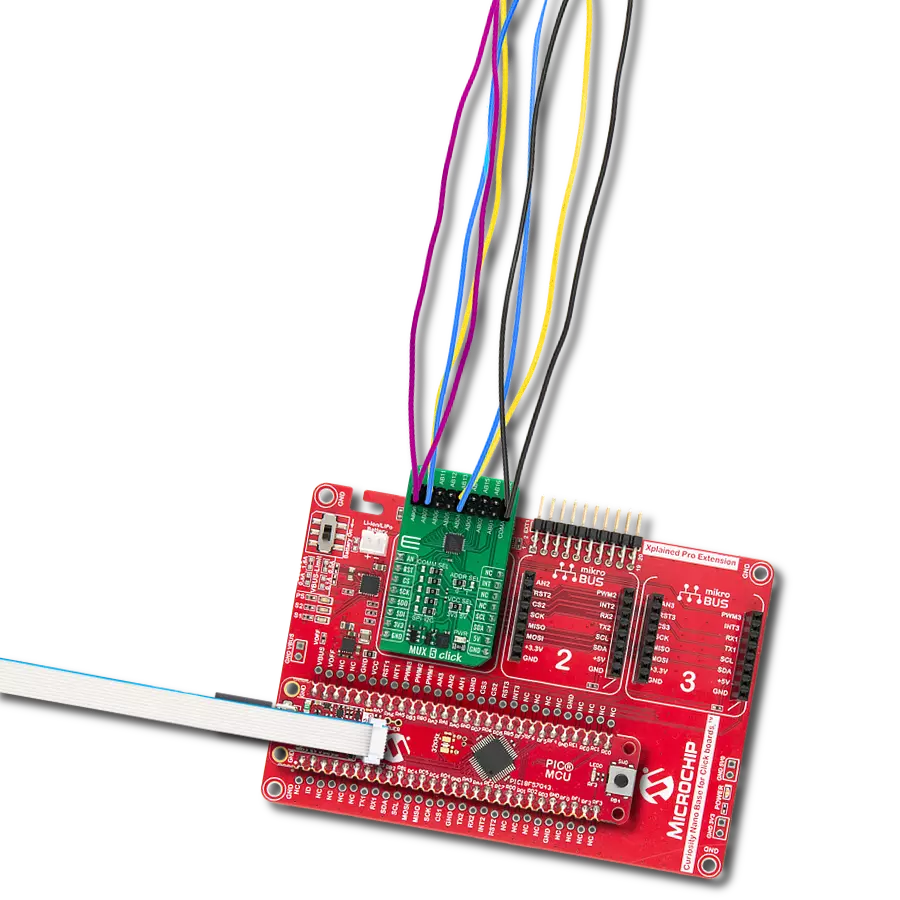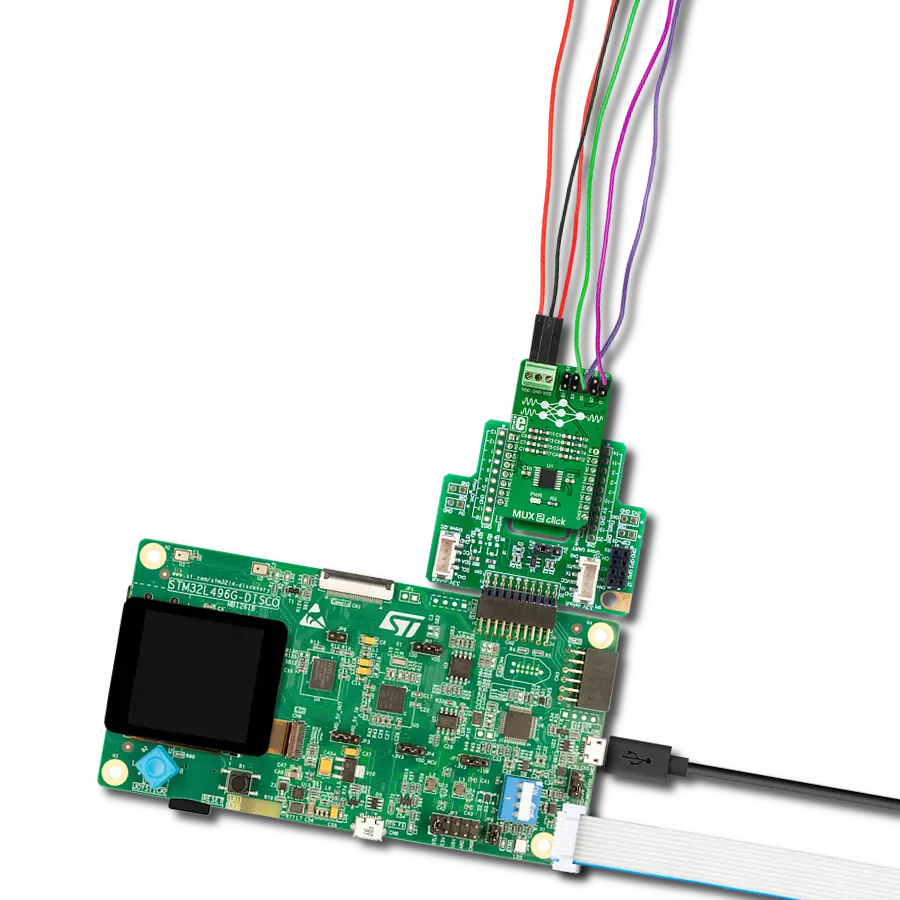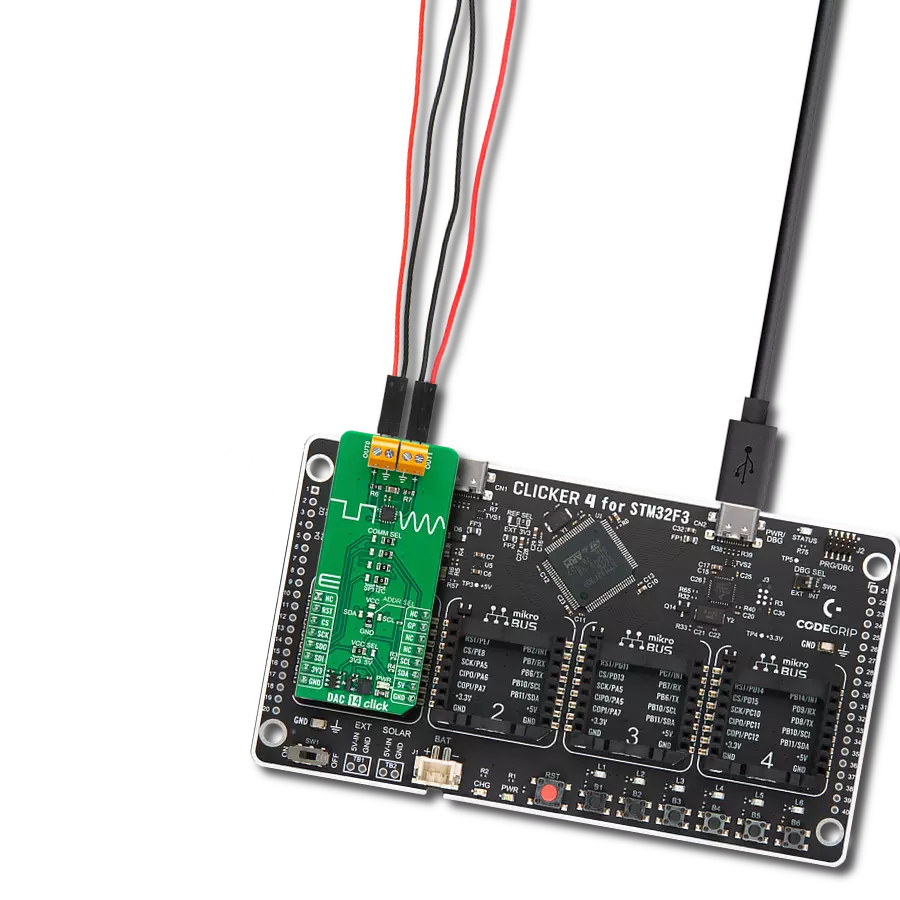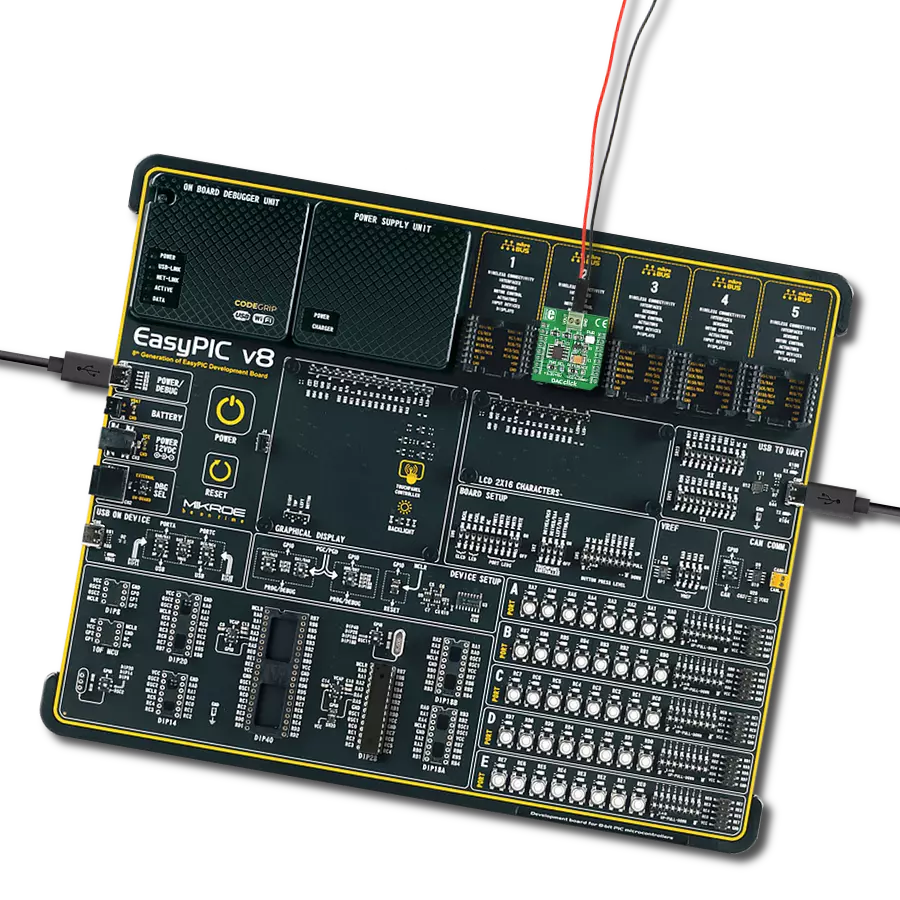Excellent choice for applications such as voltage margining and scaling, DC set-point for biasing and calibration, and waveform generation
A
A
Hardware Overview
How does it work?
DAC 16 Click is based on the DAC63204-Q1, a highly reliable, automotive-qualified, quad-channel, buffered digital-to-analog converter (DAC) from Texas Instruments. This 12-bit DAC is versatile, providing both voltage and current outputs, making it ideal for various applications such as voltage margining and scaling, DC set-point biasing and calibration, and waveform generation. One of its key features is the Hi-Z power-down mode, which ensures that the outputs maintain a high-impedance state during power-off conditions, offering additional protection and minimizing power consumption. The DAC63204-Q1 supports flexible configuration of its output channels (OUT0-OUT3). For voltage outputs, it provides a 1LSB differential non-linearity (DNL) and allows for adjustable gains, with options of 1x, 1.5x, 2x, 3x, and 4x. For current outputs, it offers a range of ±25μA to ±250μA, with 1LSB integral non-linearity (INL) and DNL (8-bit),
making it suitable for precision applications requiring fine control over current delivery. This DAC can operate using either an internal reference, an external reference (selectable via an unpopulated VREF EXT header), or the power supply itself as the reference. The full-scale output can range from 1.8V to 5V, depending on the reference source. Selection between the internal and external voltage reference is easily managed by positioning the VREF SEL jumper to either the INT or EXT position. Communication with the host MCU is made through either a 4-wire SPI or I2C interface. The SPI interface supports clock frequencies up to 50MHz, while the I2C interface operates up to 1MHz. The desired communication protocol can be selected via the four COMM SEL jumpers, with the I2C interface being set as the default. Additionally, the I2C interface allows for flexible address configuration using the ADDR SEL
jumper, offering four selectable I2C addresses (with 0x48 set by default). Beyond communication, DAC 16 Click also provides a general-purpose I/O (GP) pin, which is highly configurable for various functions, such as serving as an SDO pin, LDAC, power-down (PD), status indicator, protection, fault dump, or reset. The specific function of the GP pin can be configured through the register map and programmed into non-volatile memory (NVM) for persistent settings. This Click board™ can operate with either 3.3V or 5V logic voltage levels selected via the VCC SEL jumper. This way, both 3.3V and 5V capable MCUs can use the communication lines properly. Also, this Click board™ comes equipped with a library containing easy-to-use functions and an example code that can be used as a reference for further development.
Features overview
Development board
EasyPIC PRO v8 is a development board specially designed for the needs of rapid development of embedded applications. It supports many high pin count 8-bit PIC microcontrollers from Microchip, regardless of their number of pins, and a broad set of unique functions, such as the first-ever embedded debugger/programmer over WiFi. The development board is well organized and designed so that the end-user has all the necessary elements, such as switches, buttons, indicators, connectors, and others, in one place. Thanks to innovative manufacturing technology, EasyPIC PRO v8 provides a fluid and immersive working experience, allowing access anywhere and under
any circumstances at any time. Each part of the EasyPIC PRO v8 development board contains the components necessary for the most efficient operation of the same board. In addition to the advanced integrated CODEGRIP programmer/debugger module, which offers many valuable programming/debugging options and seamless integration with the Mikroe software environment, the board also includes a clean and regulated power supply module for the development board. It can use a wide range of external power sources, including a battery, an external 12V power supply, and a power source via the USB Type-C (USB-C) connector.
Communication options such as USB-UART, USB DEVICE, and Ethernet are also included, including the well-established mikroBUS™ standard, a standardized socket for the MCU card (SiBRAIN standard), and two display options (graphical and character-based LCD). EasyPIC PRO v8 is an integral part of the Mikroe ecosystem for rapid development. Natively supported by Mikroe software tools, it covers many aspects of prototyping and development thanks to a considerable number of different Click boards™ (over a thousand boards), the number of which is growing every day.
Microcontroller Overview
MCU Card / MCU
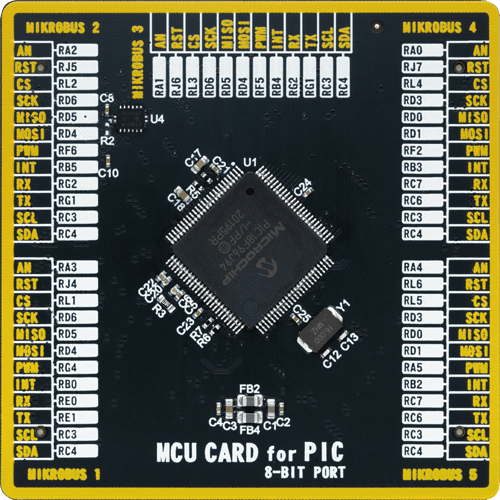
Type
8th Generation
Architecture
PIC
MCU Memory (KB)
64
Silicon Vendor
Microchip
Pin count
100
RAM (Bytes)
3862
Used MCU Pins
mikroBUS™ mapper
Take a closer look
Click board™ Schematic

Step by step
Project assembly
Track your results in real time
Application Output
1. Application Output - In Debug mode, the 'Application Output' window enables real-time data monitoring, offering direct insight into execution results. Ensure proper data display by configuring the environment correctly using the provided tutorial.

2. UART Terminal - Use the UART Terminal to monitor data transmission via a USB to UART converter, allowing direct communication between the Click board™ and your development system. Configure the baud rate and other serial settings according to your project's requirements to ensure proper functionality. For step-by-step setup instructions, refer to the provided tutorial.

3. Plot Output - The Plot feature offers a powerful way to visualize real-time sensor data, enabling trend analysis, debugging, and comparison of multiple data points. To set it up correctly, follow the provided tutorial, which includes a step-by-step example of using the Plot feature to display Click board™ readings. To use the Plot feature in your code, use the function: plot(*insert_graph_name*, variable_name);. This is a general format, and it is up to the user to replace 'insert_graph_name' with the actual graph name and 'variable_name' with the parameter to be displayed.

Software Support
Library Description
This library contains API for DAC 16 Click driver.
Key functions:
dac16_set_dac_data- This function sets the raw DAC data for the selected DAC channel.dac16_start_function_gen- This function starts the function generator for the selected DAC channel.dac16_stop_function_gen- This function stops the function generator for the selected DAC channel.
Open Source
Code example
The complete application code and a ready-to-use project are available through the NECTO Studio Package Manager for direct installation in the NECTO Studio. The application code can also be found on the MIKROE GitHub account.
/*!
* @file main.c
* @brief DAC 16 Click example
*
* # Description
* This example demonstrates the use of DAC 16 Click board by changing the voltage level
* on the OUT0 as well as the waveform signals from a function generator on the OUT1.
*
* The demo application is composed of two sections :
*
* ## Application Init
* Initializes the driver and performs the Click default configuration.
*
* ## Application Task
* Changes the voltage level on the OUT0 as well as the waveform signals from a function
* generator on the OUT1 every 3 seconds. The state of all outputs will be displayed
* on the USB UART.
*
* @author Stefan Filipovic
*
*/
#include "board.h"
#include "log.h"
#include "dac16.h"
static dac16_t dac16;
static log_t logger;
void application_init ( void )
{
log_cfg_t log_cfg; /**< Logger config object. */
dac16_cfg_t dac16_cfg; /**< Click config object. */
/**
* Logger initialization.
* Default baud rate: 115200
* Default log level: LOG_LEVEL_DEBUG
* @note If USB_UART_RX and USB_UART_TX
* are defined as HAL_PIN_NC, you will
* need to define them manually for log to work.
* See @b LOG_MAP_USB_UART macro definition for detailed explanation.
*/
LOG_MAP_USB_UART( log_cfg );
log_init( &logger, &log_cfg );
log_info( &logger, " Application Init " );
// Click initialization.
dac16_cfg_setup( &dac16_cfg );
DAC16_MAP_MIKROBUS( dac16_cfg, MIKROBUS_1 );
err_t init_flag = dac16_init( &dac16, &dac16_cfg );
if ( ( I2C_MASTER_ERROR == init_flag ) || ( SPI_MASTER_ERROR == init_flag ) )
{
log_error( &logger, " Communication init." );
for ( ; ; );
}
if ( DAC16_ERROR == dac16_default_cfg ( &dac16 ) )
{
log_error( &logger, " Default configuration." );
for ( ; ; );
}
log_info( &logger, " Application Task " );
}
void application_task ( void )
{
static uint16_t dac = 0;
static uint8_t waveform = DAC16_WAVEFORM_TRIANGULAR;
if ( DAC16_OK == dac16_set_dac_data ( &dac16, DAC16_SEL_DAC_0, dac ) )
{
log_printf( &logger, "\r\n OUT0: %u -> %.2f V\r\n",
dac, ( float ) dac * DAC16_VDD_3V3 / DAC16_DAC_DATA_MAX );
dac += 100;
if ( dac > DAC16_DAC_DATA_MAX )
{
dac = DAC16_DAC_DATA_MIN;
}
}
err_t error_flag = dac16_stop_function_gen ( &dac16, DAC16_SEL_DAC_1 );
error_flag |= dac16_config_function_gen ( &dac16, DAC16_SEL_DAC_1, waveform,
DAC16_CODE_STEP_32_LSB, DAC16_SLEW_RATE_4_US );
error_flag |= dac16_start_function_gen ( &dac16, DAC16_SEL_DAC_1 );
if ( DAC16_OK == error_flag )
{
log_printf( &logger, " OUT1: " );
switch ( waveform )
{
case DAC16_WAVEFORM_TRIANGULAR:
{
log_printf( &logger, "triangular wave at about 1kHz\r\n" );
waveform = DAC16_WAVEFORM_SAWTOOTH;
break;
}
case DAC16_WAVEFORM_SAWTOOTH:
{
log_printf( &logger, "sawtooth wave at about 2kHz\r\n" );
waveform = DAC16_WAVEFORM_INV_SAWTOOTH;
break;
}
case DAC16_WAVEFORM_INV_SAWTOOTH:
{
log_printf( &logger, "inverse sawtooth wave at about 2kHz\r\n" );
waveform = DAC16_WAVEFORM_SINE;
break;
}
case DAC16_WAVEFORM_SINE:
{
log_printf( &logger, "sine wave at about 10.5kHz\r\n" );
waveform = DAC16_WAVEFORM_DISABLE;
break;
}
case DAC16_WAVEFORM_DISABLE:
{
log_printf( &logger, "function generator disabled\r\n" );
waveform = DAC16_WAVEFORM_TRIANGULAR;
break;
}
default:
{
log_printf( &logger, "unknown state\r\n" );
break;
}
}
// OUT2 and OUT3 are set in dac16_default_cfg
log_printf( &logger, " OUT2: sine wave at about 10.5kHz\r\n" );
log_printf( &logger, " OUT3: sawtooth wave at about 2kHz\r\n" );
}
Delay_ms ( 1000 );
Delay_ms ( 1000 );
Delay_ms ( 1000 );
}
int main ( void )
{
/* Do not remove this line or clock might not be set correctly. */
#ifdef PREINIT_SUPPORTED
preinit();
#endif
application_init( );
for ( ; ; )
{
application_task( );
}
return 0;
}
// ------------------------------------------------------------------------ END




















